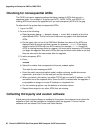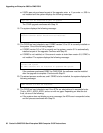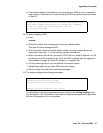
Upgrading an Enterprise 3000 to CMS R3V9
30 CentreVu CMS R3V9 Sun Enterprise 3000 Computer CVUE Instructions
Checking for nonsequential ACDs
The CVUE tool cannot upgrade systems that have a series of ACDs that are not in
sequential order. For example, if a system has ACD1, ACD2, ACD4, and ACD5, it is
missing ACD3 and cannot be upgraded until you add a temporary ACD to fill the gap.
To determine if the system has nonsequential ACDs:
1. Log on to CMS.
2. Do one of the following:
● Select System Setup > Switch Setup > List All to display a list of the
administered ACDs. This list will show if there are any gaps in the administered
ACDs.
● On the upper right corner of the CMS Main Window, the status of the ACDs are
displayed with up arrows and down arrows (for example,
∧∨∧∧∨
). If the display
shows a series of ACDs with one ACD missing (for example,
∧∨
∧∨
shows that
ACD3 is missing because there is a space), you must add a temporary ACD before
you begin the upgrade. Note which ACDs were up and which were down to see that
they are returned to the same state after the upgrade.
3. To add a temporary ACD:
a. Enter:
cmsadm
b. Select the number that corresponds to the acd_create option.
This adds the next unassigned ACD.
c. Enter the switch name and switch model, enable vectoring, enable disconnect
supervision, and enter 1 for the local port and the remote port.
d. When you select a link device, use either TCP/IP with an invalid IP address, or X.25
and select one of the loopback links. Since the ACD is deleted after the upgrade, it
is acceptable to assign an invalid IP address or a loopback link.
e. For the remaining options, use the defaults or minimum values.
f. Repeat these steps for any other ACDs that are missing.
Collecting third-party and custom software
If third-party and custom software is installed on the system, the customer must collect the
software so that it will be available for installation after the upgrade. This can include
software such as Internet Call Center and Visual Vectors.


















